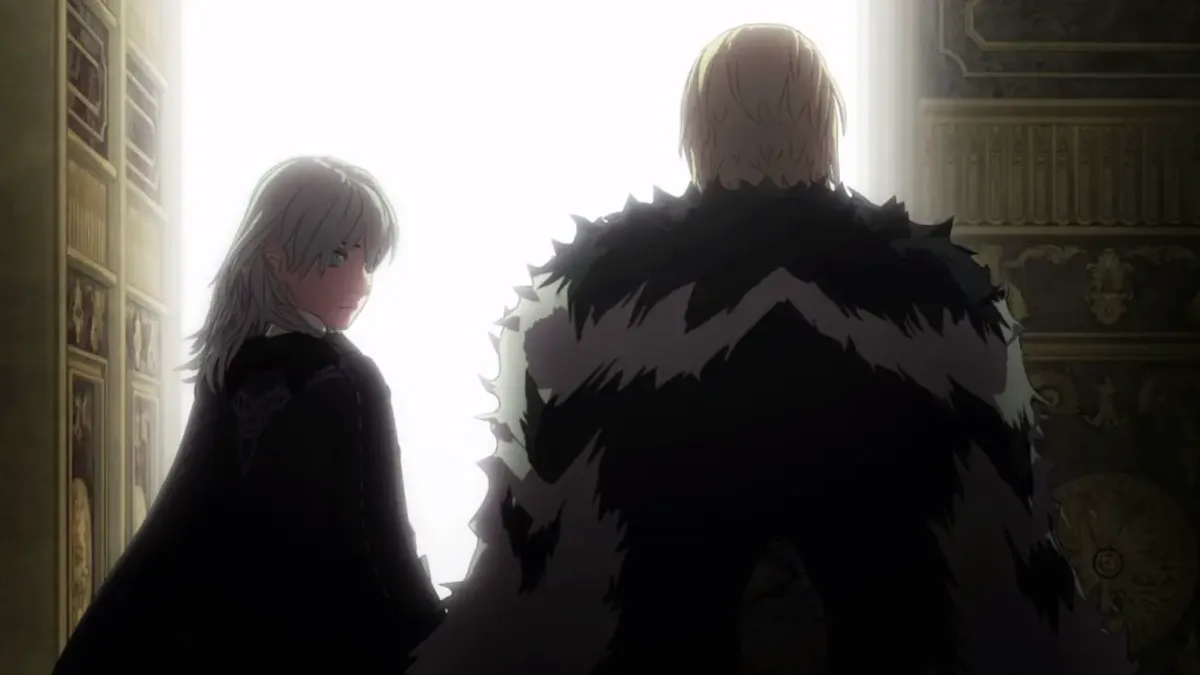
My brother and I have been playing Fire Emblem games since 2003. We’ve played the entire series of these turn-based tactical RPGs, even the Japan-exclusive ones. His favorites are the Jugdral games, which came out for the Super Famicom in the late 90s. I’m a bit more partial to 2005’s Path of Radiance, but I did enjoy Genealogy of the Holy War from 1996 quite a lot.
He doesn’t have a Switch yet, so he asked me a couple weeks ago what Three Houses is like. My initial response was that it combines some of the best elements of Genealogy of the Holy War, Blazing Blade, Path of Radiance, New Mystery of the Emblem, Fates, Shadows of Valentia, and Heroes. I’ve never seen my brother look more confused in my life, and remember, he’s played all of those games (some of them multiple times)! As I went into more detail, he began to understand what I meant, and he came up with a more accurate summary: Three Houses kept the elements from Shadows of Valentia that worked well and brought back a few other things from previous games that make for a richer experience.
Prior to writing this review, I have finished the Blue Lions route of the game, so there will be clearly marked spoiler and non-spoiler sections. Reader discretion is advised.
Part 1: Non-Spoiler Section
The game begins with a cutscene showing a battle that took place long before the events of the game. As hundreds of soldiers fight around them, a woman named Seiros defeats a fallen hero called Nemesis, who had apparently killed her mother. This turns out to be a dream that the avatar character had. The avatar character (default name Byleth) in this game is mostly silent, like in Blazing Blade, which I think is the best way to handle an avatar. You do get dialogue options that sometimes make the character you’re talking to like or dislike you, but all of the other characters in the game, even the most shy and the most taciturn, talk a lot more than Byleth does. Unlike the avatar characters in Awakening and Fates, you cannot alter Byleth’s appearance beyond simply choosing between male and female versions of the character; this allows them to be fully included in pre-rendered video cutscenes, which was not possible with the customizable appearances of Robin and Corrin.
Much like Shadows of Valentia, Three Houses has full voice acting on every line of dialogue, not just in cutscenes. When I first found out that the voice director of this game was Patrick Seitz and not Wendee Lee, I was disappointed. Lee was the director for Shadows of Valentia, which has some of the best voice acting across the board that I’ve ever heard. I thought there was no way that the director of the mostly mediocre voices in Fire Emblem Warriors could match Lee’s level of quality. But I’m happy to say I was wrong. Three Houses absolutely maintains the top-level quality of voice acting that Shadows of Valentia introduced.
And if that wasn’t enough of a treat for your ears, the music is absolutely phenomenal, especially in the second half of the game. I’ve actually paused mid-battle conversations just to listen to some music longer. That was before I realized the game’s Music Library could be found under Extras on the main menu; now I just spend ridiculous amounts of time listening to the music there. I’m particularly fond of the tracks “Chasing Daybreak,” “Between Heaven and Earth,” “Paths That Will Never Cross,” and “A Vow Remembered.”
Shortly after Byleth awakens from the dream, three characters named Edelgard, Dimitri, and Claude arrive to ask Byleth and his/her father, Jeralt, for help in defeating some bandits. This is a pretty standard Fire Emblem trope: some of the earliest battles in most FE games are against small-time bandits. This gives you a chance to familiarize yourself with the basics and feel heroic by fighting against enemies who aren’t used to battling against those who can fight back. Byleth, a mercenary, takes the field alongside future empress Edelgard, future king Dimitri, and future noble heir Claude. They are from the Adrestian Empire, the Kingdom of Faerghus, and the Leicester Alliance, respectively; these three countries make up the continent of Fódlan. Each wields a different type of weapon: Edelgard wields a heavy and inaccurate yet strong axe, Byleth wields a light and accurate but weak sword, Dimitri wields a lance that strikes a balance between them, and Claude carries a bow, allowing him to attack from a distance.
Unlike every Fire Emblem game from Genealogy through Fates, Three Houses does not include an inherent weapon triangle. In previous games, using a lance against a sword would automatically increase the lance user’s accuracy and dodging, while using an axe against a lance would provide the axe user with the same benefit, and using a sword against an axe would provide this benefit to the sword user. Not so in Three Houses. Instead, characters must reach a certain level of proficiency with a type of weapon in order to learn abilities that give them an advantage over other weapon types. Until then, you can choose what weapon to use solely based on the best combination of accuracy, damage, and weight for each situation (more on weight later).
But that’s not the only thing you can learn by reaching higher levels of weapon proficiency. Each type of weapon has certain arts associated with it—special moves that give bonuses to your accuracy, damage, and/or critical hit chance, as well as other effects in some cases. This is a returning mechanic from Shadows of Valentia; however, since learning these arts is based on the character’s proficiency with a type of weapon rather than their experience with a specific weapon, the arts can be used with any weapon of the appropriate type. For example, in Shadows of Valentia, the Curved Shot art could only be used while carrying an Iron Bow; in Three Houses, once you learn the art, you can use it with any bow, but you wouldn’t be able to use it with a sword. Also, instead of costing HP like in Shadows of Valentia, arts now cost extra durability from the weapon you’re using.
A new feature you may notice in your first battle is that you can now see a glowing red line arcing from each enemy toward the character they plan to attack if they’re close enough. These lines will update in real time whenever a more tempting target enters their attack range, even when you’re in the middle of deciding where to move and haven’t yet confirmed your decision, which is very helpful. However, if there are many enemies close together and one gets in the way of another, the one who acts later may target a different character instead, so there’s no guarantee that someone in the enemy’s attack range is safe just because there isn’t a red line pointing at them.
The battle against the bandits ends with the story’s explanation for another returning mechanic from Shadows of Valentia: the Divine Pulse, previously known as Mila’s Turnwheel. Essentially, it’s an undo button. You get a limited number of Divine Pulse usages per battle, but each one can go back as far as you want, and you can choose the exact point that you want to start from on a move-by-move basis, whether it’s at the beginning of a turn, somewhere in the middle, or one move before the end. You will see a list of the characters’ actions and their results, and the map will update in real time to show you what things would look like if you chose that point to start from. I love this; it’s a huge time saver because in most cases, if a character dies, I would restart the chapter and make most of the same moves anyway up until that one wrong move that got the character killed.
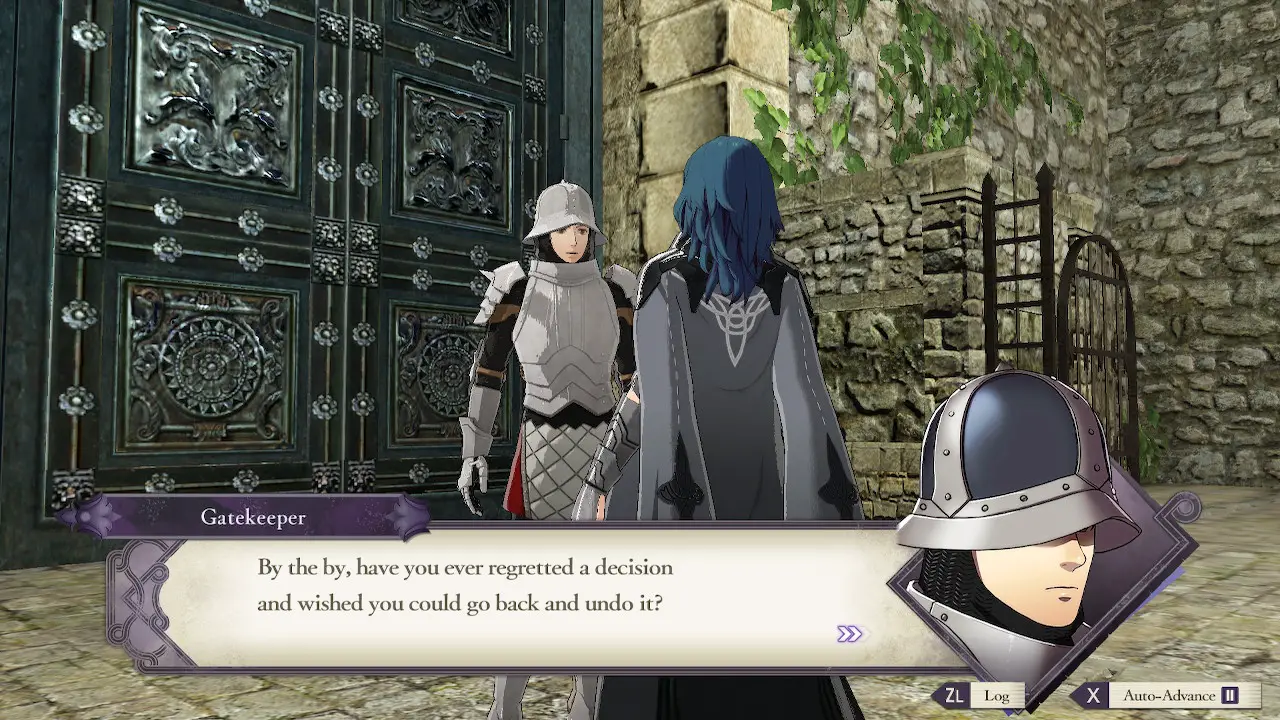
Everybody’s favorite NPC, the Gatekeeper. He was voiced by Kyle McCarley, who also voiced Alm, one of the main protagonists of Shadows of Valentia.
Speaking of characters dying, Three Houses includes the option to choose between Classic Mode, where characters who die stay dead permanently, and Casual Mode, where they survive and retreat if defeated. This has been a series staple since the Japan-exclusive New Mystery of the Emblem in 2010. If the possibility of characters dying permanently stresses you out, Casual Mode will be more enjoyable; on the other hand, if you find the life-and-death stakes exciting, you can stick with Classic Mode. Separately, you can choose between Normal and Hard difficulty—Hard Mode makes enemies tougher and adds more of them to each battle.
After Byleth hosts FódlanTube Rewind, a boisterous knight named Alois appears on the scene. He knew Jeralt 20 years ago, and he asks Jeralt and Byleth to come with him and the other three back to Garreg Mach Monastery. This is a military academy located on the borders of all three nations; it is run by the Church of Seiros, the largest religion in Fódlan. Strangely, the leader of the church, Archbishop Rhea, immediately hires Byleth as a professor to teach one of the classes; it’s pretty plain that she knows more about Byleth than she’s willing to admit. Regardless, this is when you choose which class, or house, you want to teach. The Black Eagle house, led by Edelgard, has students from the Adrestian Empire. The Blue Lion house, under Dimitri’s leadership, has students from the Kingdom of Faerghus. The Golden Deer house is headed by Claude and has students from the Leicester Alliance.
Regardless of which house you pick, the flow of gameplay runs on an in-game calendar. Each in-game month, your class will be assigned a mission from the church. At the beginning of the month, you receive a stipend to buy weapons and items for your students. Every in-game Sunday, you can choose to explore the monastery, attend a seminar on certain skills hosted by another member of the academy’s faculty, fight extra battles outside of the ones tied to the main story, or rest. Exploring the monastery is like a combination of the villages and the real-time dungeon crawls in Shadows of Valentia; it gives you a chance to run around and talk to students, other professors, and NPCs. You can scan amiibos at the Amiibo Gazebo to get some extra goodies; any amiibo will work, but Fire Emblem characters give better items. You can do sidequests to earn some extra money and items, and you can also recruit characters from other houses into yours (although some will never join you, such as the leaders of other houses and their most loyal servants). Most characters will join your house if you raise certain skills and stats high enough, depending on what they want to learn. The exception is Sylvain, who is obsessed with women and can be recruited immediately by female Byleth regardless of her skills and stats.
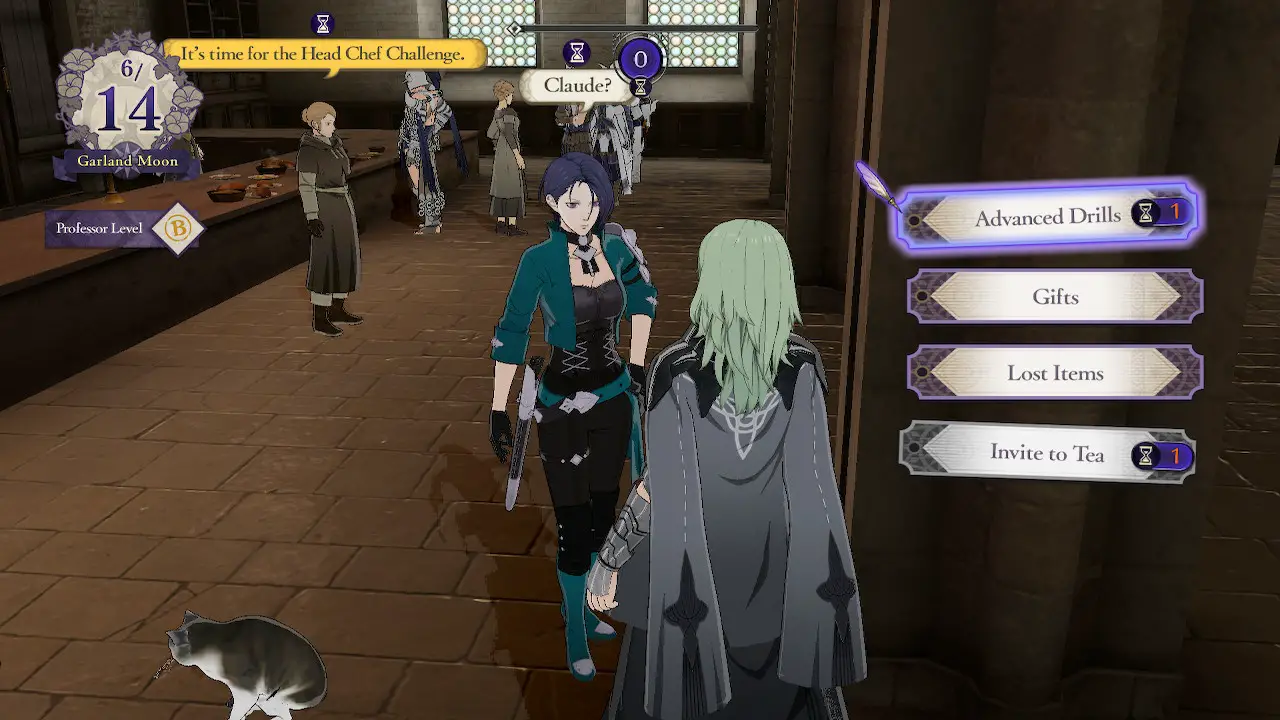
Even a no-nonsense mercenary can’t resist the Golden Deer memes!
Three Houses also has new online features. You can see which characters are being used the most often worldwide, you can get a few extra goodies from the Online Liaison, and you can also see where on each battlefield most character deaths/retreats have occurred…if the connection is successful. I tried using this feature at first, but before long, I noticed that I was having unsuccessful connections more often than not. This was despite having a wired connection via USB ethernet adapter. To be fair, this was at launch, so probably the highest traffic time, but it was still disappointing, and I’m hesitant to try it again.
Although Byleth starts out carrying a sword, you don’t have to stick with swords only, which makes it much easier to build up your other skills and recruit students who want to learn other things. Most classes can use any type of weapon in the game, although stronger weapons within a given category require higher levels of proficiency. But the Myrmidon class, for example, can use swords, lances, axes, and/or bows in this game, as opposed to previous Fire Emblem games that only allowed them to use swords. The game also introduces a new weapon type: gauntlets. These are very weak but guarantee that the character will make twice as many attacks as normal on their turn, similar to how Brave weapons work in Fire Emblem Fates and Heroes. On the enemy’s turn, your counterattacks are not doubled, so it’s good to avoid having gauntlets equipped except when you’re attacking with them on your turn.
Because of their low power, gauntlets are best in the hands of characters with high Strength, and they help to compensate for a low Speed stat, which normally helps with extra attacks. As in all FE games since 1999’s Thracia 776, characters with higher Speed can make follow-up attacks against targets with lower Speed. But Three Houses makes a return to Path of Radiance’s way of handling this, in that different weapons have different amounts of weight, with heavier ones reducing the wielder’s Attack Speed (displayed as AS); a character’s Strength stat mitigates this weight penalty at a rate of 1 point of weight canceled per 5 points of Strength. Follow-up attacks require an Attack Speed difference of 4 or more between the two combatants.
Most classes can use any type of weapon, but only a handful of classes can use magic. There are three types of magic in Three Houses:
- White Magic, which encompasses healing, status effects like Silence (preventing targets from casting magic), and light-based attack spells; this comes from the Faith skill.
- Black Magic, which includes lightning, fire, wind, and ice-based attack spells; this comes from the Reason skill.
- Dark Magic, which often has added effects on targets beyond just damage, but can only be learned by a select few characters; this also comes from the Reason skill.
Spells, like weapons, each have different amounts of damage, accuracy, and weight, and they still require Strength to mitigate their weight, although they use the Magic stat to calculate damage. Any class that can use magic can use any type of magic that the character knows. Different characters learn different spells at different skill levels. This is yet another returning mechanic from Shadows of Valentia, though slightly changed in that spells learned depend on your Reason and Faith skills rather than character levels. Another difference is that instead of costing HP to cast these spells, they just have a limited number of uses allowed per battle. This aspect is brand-new to the series, as it is also different from the previous system where spellbooks were acquired in the same way as weapons and would eventually run out of power just like weapons breaking.

Sadly, you cannot pet the dogs in Fire Emblem: Three Houses. Nor the cats, for that matter. I could make a joke about Fates localization, but that would be too easy.
All characters available at the beginning of the game start out in either the Commoner or Noble class. These classes are functionally the same, except that the Noble class has slightly more growth potential in the Charm stat. Charm, a new stat that’s never been in Fire Emblem before, adds to a character’s accuracy and damage when commanding a large group of nameless soldiers in what’s called a Gambit attack. Once they hit Level 5, the students can take an exam to qualify for one of the Beginner classes, all of which are stronger than Noble and Commoner. A character’s chance of passing the exam depends on how close they are to the class’s suggested skill levels; if they have all of the suggested skill levels, they are guaranteed to pass the exam. At Level 10, they can take exams for Intermediate classes; Level 20 unlocks Advanced classes, and Level 30 gives access to Master classes. You can freely reclass among all the classes you’ve passed the exams for at any time except during battles; this reminds me of New Mystery of the Emblem, where reclassing is at its easiest.
By now, you may be wondering: if magic-using classes can use magic and weapons, but other classes can only use weapons, and you can have any character take the exam for most classes, why wouldn’t you just put every character into a class that can use magic, then? Five reasons:
- Some characters will never be good at magic, no matter how hard you try to make them good at it; putting them in magic classes will only hold back their stat growth in other areas in the long term.
- Magic-using classes usually can’t move as far per turn as other classes, except for Dark Knight, Holy Knight, and Mortal Savant, which are Master classes.
- There are no magic-using classes that can fly (some classes ride wyverns and pegasi); strong fliers can make many battles much easier by flying over obstacles, as long as you have a way of avoiding or eliminating enemy archers, who gain large damage bonuses when they use bows against fliers.
- Most magic-using classes can’t equip gauntlets. The only other classes that face this restriction are mounted classes, such as Cavaliers and Pegasus Knights.
- With a small handful of exceptions, Archers, Snipers, and Bow Knights outrange magic users and can counterattack even against melee attackers once they hit bow rank C, much like in Shadows of Valentia.
Speaking of mounted classes, the Canto ability, first seen in Genealogy and included through Radiant Dawn (although the Game Boy Advance titles in between featured a nerfed version), makes a return in Three Houses. If a character in a mounted class doesn’t use up all of their movement squares before taking an action, they can use up their remaining movement squares after taking the action. Cavaliers have 7 squares of movement; if one moves 3 squares to attack an enemy, they can then move 4 more squares after attacking.
Another returning feature first seen in Genealogy is an element of both gameplay and story where certain bloodlines carry special powers and the exclusive ability to make use of specific legendary weapons called Hero’s Relics. In Genealogy, this was called holy blood; Three Houses instead calls these powers Crests. Some students have them and others don’t. Those that have them don’t always benefit from them, but they’re usually at least somewhat beneficial and never a detriment. Hanneman, a magic user with low Strength, has a Crest that benefits his weapon attacks, which is basically useless. By contrast, Annette, another magic user, has a Crest that can allow her to cast more Black Magic spells per battle, and that can make a huge difference in longer fights. And of course, Crests aren’t restricted to just magic users; Catherine, a Swordmaster, has a Crest that sometimes makes her arts stronger; she also owns a Hero’s Relic called Thunderbrand. A Hero’s Relic can be used by anyone with the appropriate weapon level, but characters without a Crest will take a big chunk of damage after each attack, even if it’s an enemy attacking from a distance at which the wielder can’t counterattack. A character with a Crest that doesn’t match the weapon can use it without taking damage, but a character who has the right Crest (in this case, the Crest of Charon), gains the use of a unique and powerful art when wielding the weapon.
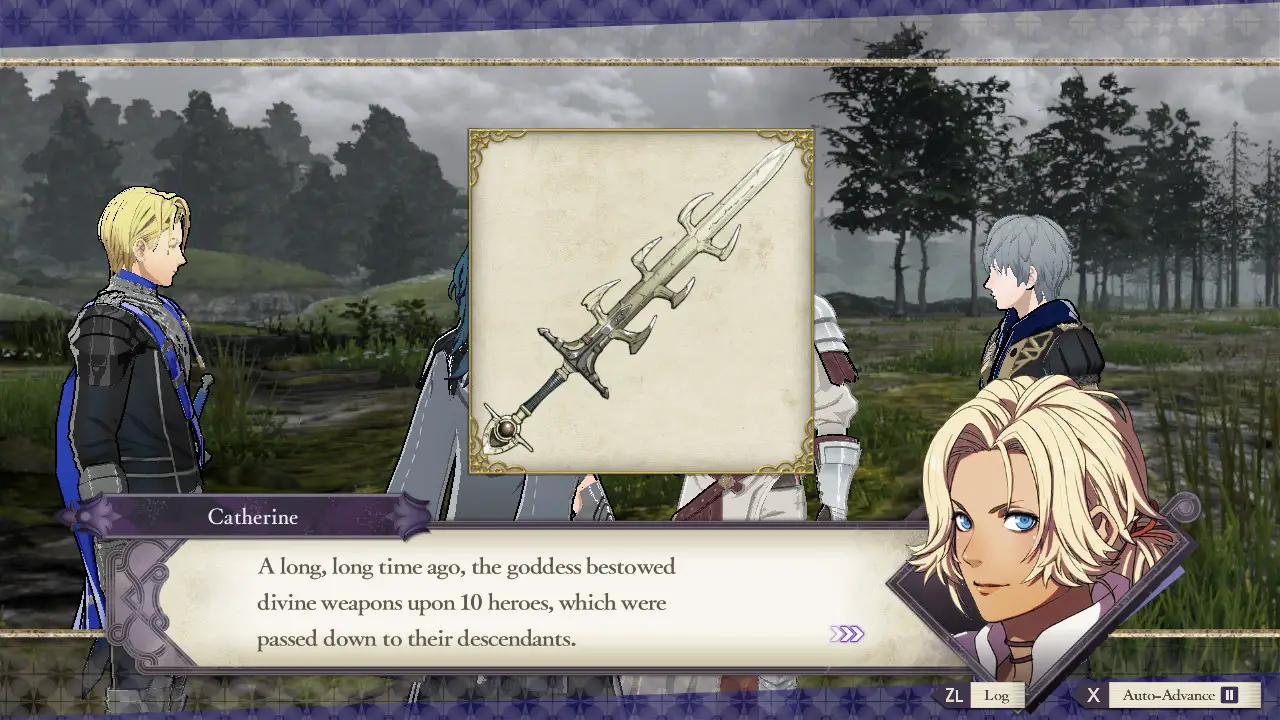
Let’s be real, that’s a totally impractical design for a sword.
Catherine and her Thunderbrand are first seen in action in a battle that features the only returning game mechanic that definitely shouldn’t have come back: fog, first seen in Thracia 776. In some battles, you can’t see your enemies until you get close to them, but they can always see you. Torches can help by extending your range of vision, but most of the time, you’re going to be stumbling around blindly and falling into ambush after ambush. This doesn’t feel like a fun challenge; it just feels like bullshit. In my opinion, one of the best things about the 3DS Fire Emblem titles was that they did away with fog entirely. Even the infamous ice bomb battle from Fates: Revelation, often equated to fog by fans, was better than true fog because the enemies couldn’t move until you could see them.
Unlike most other Fire Emblem games, Three Houses has a New Game+ feature for repeat plays, where you can use the Renown you earned from fighting and doing side quests to buy back things like skill and support levels that your characters had in your previous run. This makes it much easier to recruit a lot of characters; in fact, in my current New Game+ Golden Deer run, I have every recruitable character on my side.
Apart from the fog and the questionable online functionality, Three Houses overall has probably the best and most refined game mechanics in the series. But game mechanics alone do not make a Fire Emblem game great; this is a character-driven series. So how good are the characters and story in Three Houses? Pretty damn good, for the most part. Far better than most of those of Awakening and Fates, in my opinion. Much of the game’s characterization is handled within special dialogues called support conversations. If two characters fight near each other often enough, they’ll be able to have a conversation back at the monastery; after that conversation, they fight better when they’re near each other. This feature has been a staple of the Fire Emblem series since Binding Blade, but this time, like in Shadows of Valentia, the conversations are fully voiced, and the acting is superb. If you want more detail on the characters and story, you must be prepared to read some spoilers; however, my closing remarks do not contain spoilers, so feel free to scroll past this section to reach them.
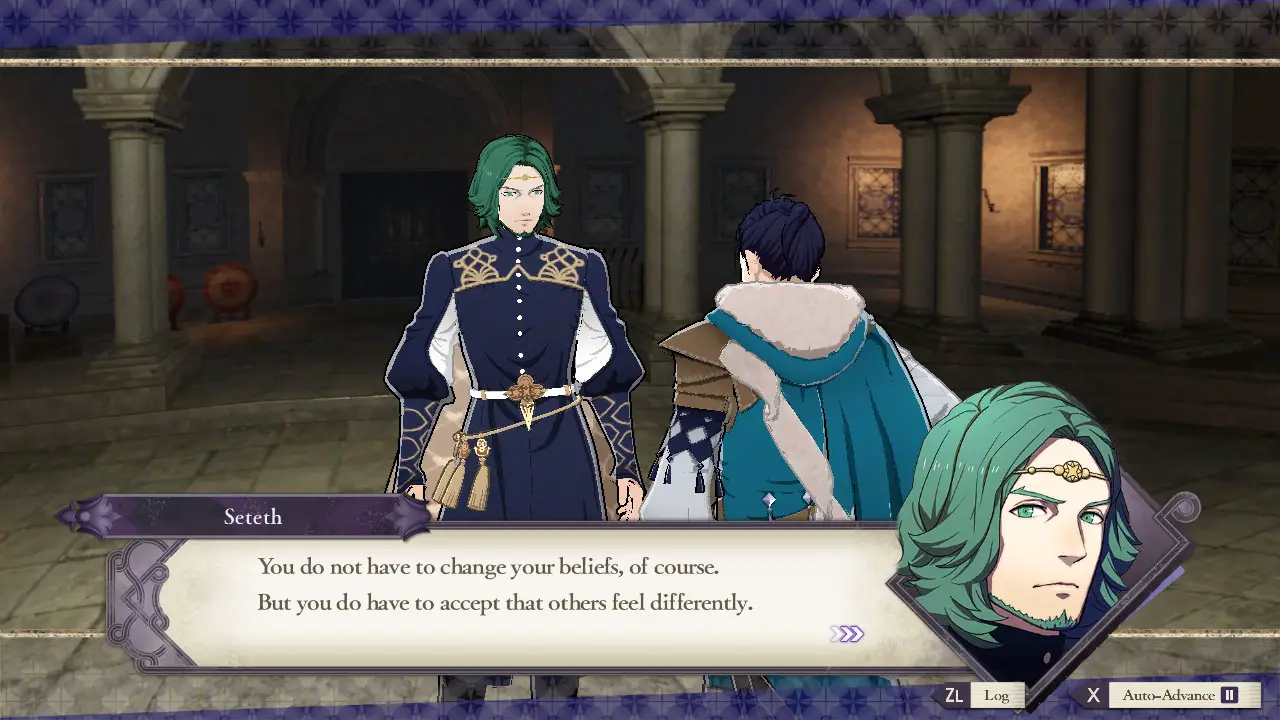
Is Seteth talking to Felix or to the fanbase?
Part 2: Spoiler Section
As stated above, I chose to lead the Blue Lion house for my first run of the game, but all three houses follow roughly the same main events until Chapter 11. This reminds me of the Blazing Blade, where Eliwood’s Story and Hector’s Story follow most of the same events from slightly different perspectives and focus on different characters. In the Blue Lions, the story mainly revolves around Dimitri, who is aided by his loyal servant Dedue and also by other students from the Kingdom of Faerghus: Felix, Annette, Mercedes, Sylvain, Ingrid, and Ashe.
I loved the complexity of Dimitri as a character: always striving for justice, but deeply emotionally scarred by the Tragedy of Duscur. This event began four years before the beginning of the game with a massacre that claimed the lives of Dimitri’s father, Ashe’s adoptive brother, and Ingrid’s fiancé (who was Felix’s brother) as well as many civilians, and the people of the Duscur region of Faerghus were blamed, although Dimitri knew they weren’t guilty. In retaliation, despite Dimitri’s protests, the kingdom slaughtered many innocent people in Duscur. Dedue would have been one of these victims if Dimitri hadn’t saved his life. Ever since, Dedue has pledged his absolute loyalty to Dimitri. It’s not apparent at first—he hides it well behind a mask of politeness and respect—but Dimitri remains haunted by this event years later and is driven by survivor’s guilt and a lust for revenge against whoever was truly behind the massacre.

Don’t pick the answer I have highlighted here. He doesn’t like it.
The game’s paralogues (side story battles) are often used to expand on the backgrounds of non-main characters, which I think is a brilliant move—it makes the player care more about characters who don’t get the spotlight during the main story. It also gives the player a chance to get many different Hero’s Relics for good reasons without the main story taking any detours for them. In some past Fire Emblem games, significant chunks of the story have involved obtaining legendary weapons, and it kind of feels unnecessary to the rest of the story. In other FE games, legendary weapons just appear out of nowhere for no good reason. Three Houses’ approach is a significant improvement over either of these options.
I started the game expecting Jeralt to die, since Eliwood in The Binding Blade is the only father to a Fire Emblem Lord who’s ever survived, but he took so much longer than I expected that I almost started to think that he might survive after all. When that turned out not to be the case, I really appreciated that Byleth tried to save him in the cutscene by using the Divine Pulse to rewind time, just as most players would do if a character died during gameplay. If Byleth hadn’t at least tried, I’m sure there would be all kinds of memes about how they forgot about the Divine Pulse, or they just didn’t care that much about Jeralt, or whatever. But this way, it really feels like something that couldn’t be prevented.
Once the true identity of the Flame Emperor is revealed and Edelgard begins her conquest, each house responds slightly differently; shortly afterwards, Byleth is cast into a deep, dark chasm, where they sleep for the next five years. I was caught completely off guard by this plot twist. In hindsight, it seems obvious that the Flame Emperor would be someone important in the Adrestian Empire. But I never thought one of the main protagonist options from the beginning of the game could turn out to be the main villain! The identity of the Death Knight, on the other hand, was immediately obvious to me. As a Hector fan who played Fire Emblem Heroes for two years, I know Patrick Seitz’s voice very well. What was less obvious about him, of course, was his relationship to Mercedes.
When Byleth awakens and reunites with Dimitri five years later, he’s a shell of the man he once was. He’s alone and broken, living only to kill those he deems evil, or anyone else who would get in the way of his revenge against Edelgard. And he also considers himself evil for all the killing he’s done. His mask has come all the way off; all that remains is a beast that revels in bloodshed, living in the ruins of the abandoned Garreg Mach Monastery. I thought the “five-year reunion” reasoning for all of the former Blue Lions coming back to help him was a little bit questionable, but not so much that it broke my immersion in the story.
What did slightly break my immersion in the story was that sometimes it didn’t really make sense for the characters to return to the partially restored monastery. Classes are no longer in session, so I feel like it would have made more sense for an army camp to take the place of the monastery as the location where Byleth runs around and talks to soldiers and NPCs and does sidequests. Even so, I appreciate that Dimitri can’t partake in support conversations at first. For gameplay purposes, it’s an inconvenience, but given Dimitri’s state of mind, it completely makes sense. It would be weird if he was if he was all dark and broody in the main story and back to normal in the support conversations.
Of all the non-main characters, the one who matures the most noticeably is Felix. Before the five-year timeskip, he’s consistently abrasive to almost everyone, and he basically only cares about becoming the strongest swordsman he can possibly be (to be fair, it seems to work pretty well for him, because he’s definitely one of the strongest characters in the game). I didn’t like him very much at first because of this. But five years later, he softens considerably and shows that he cares about his friends much more readily. Not to the point that he seems like a completely different character, but a wiser, more mature version of his past self. It’s just one example of this game’s mostly excellent writing.
Dimitri is informed that many of his people are suffering under the Empire’s rule and only a small resistance faction remains, but he doesn’t care. Instead, he leads his army in an awkwardly forced callback to a mock battle between the three houses five years ago. Claude has no good reason to partake in this battle as long as the Imperial and Kingdom armies don’t take their fight to Leicester soil. This was the only time in the game when I thought an aspect of the story was stupid: Claude is supposed to be smart and level-headed, so it would have made so much more sense for him to simply hold his troops back and watch the battle from the sidelines to make sure Leicester stayed safe, but instead, he attacks both armies.
In the battle’s aftermath, a civilian tries to stab Dimitri in the back, but Felix’s father sacrifices himself to save Dimitri. This, along with Byleth’s guidance, finally brings Dimitri to his senses, and he returns to Faerghus to help his people and save his kingdom. No sooner has Dimitri retaken the kingdom’s capital than a messenger arrives requesting aid for Leicester against the Empire. Dimitri answers the call and then, with the approval of the Leicester Alliance Council, Claude hands control of Leicester over to Faerghus.
With Leicester and Faerghus united, Dimitri finally has the military might to challenge the Empire properly. But before he does, he insists on meeting with Edelgard peacefully in private to ask her reasons for her conquest, since they briefly lived as step-siblings when they were young. Edelgard explains that she was fed up with the way non-Crest-bearers are often treated as second-class citizens by the church. Dimitri argues that attempting to reform the world doesn’t justify this bloody war, and they conclude that they cannot settle their differences peacefully. Each departs to prepare for the final battle. The story reaches a satisfying conclusion with Edelgard’s demise after a long and difficult fight.
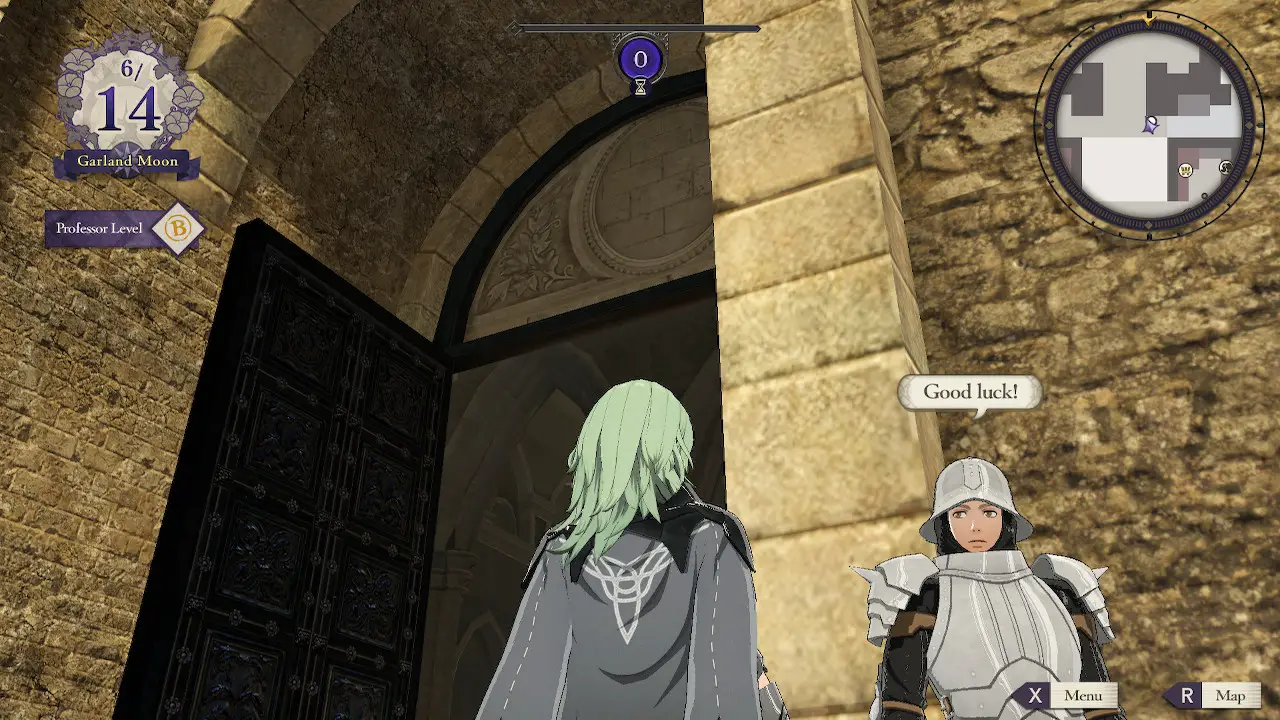
Thanks, Gatekeeper! Good luck to you, too!
Fire Emblem: Three Houses
Excellent
Fire Emblem: Three Houses is the best Fire Emblem game since 2005’s Path of Radiance. Players who skipped Shadows of Valentia may find a lot of things strange and different at first, but it all fits together so well that it starts to feel natural pretty quickly. Even if you don’t know what you’re doing in the beginning, you can still succeed and enjoy playing in the long run. The story is fascinating, the characters are lovable and entertaining, and the presentation is great.
Pros
- Excellent voice acting
- Well refined and engaging game mechanics
- Characters are more customizable than ever
Cons
- Some characters are a bit one-note
- Story has very occasional weak moments
